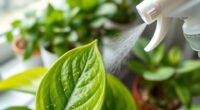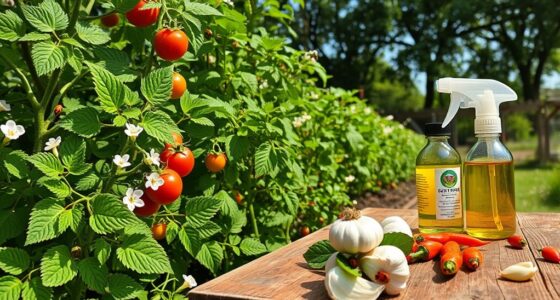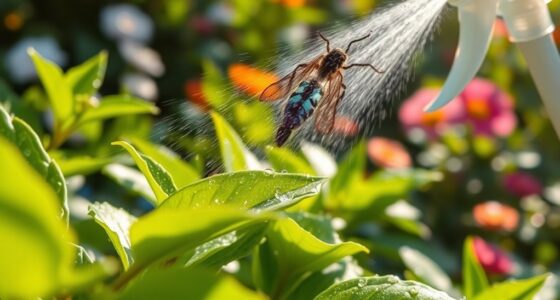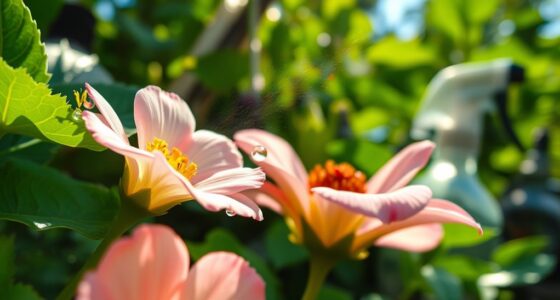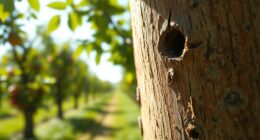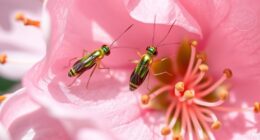To use Bacillus thuringiensis (Bt) safely in your vegetable garden, select the right formulation for your pests and apply during early morning or late evening to protect beneficial insects and pollinators. Use protective gear, spray evenly on all leaf surfaces, and avoid applying before rain or wind. Store Bt properly in a cool, dry place and follow label instructions for best results. Keep pest monitoring ongoing; if you continue exploring, you’ll find even more ways to protect your garden responsibly.
Key Takeaways
- Wear protective gear such as gloves, masks, and goggles during handling and application.
- Apply Bt during early morning or late evening to protect pollinators and beneficial insects.
- Store Bt in a cool, dry place away from sunlight and heat, keeping containers tightly sealed.
- Spray evenly on all leaf surfaces, especially undersides, avoiding runoff and drift during calm weather.
- Regularly monitor pest activity and environmental conditions to apply Bt responsibly and avoid unnecessary use.
Understanding How Bacillus Thuringiensis Works in Your Garden
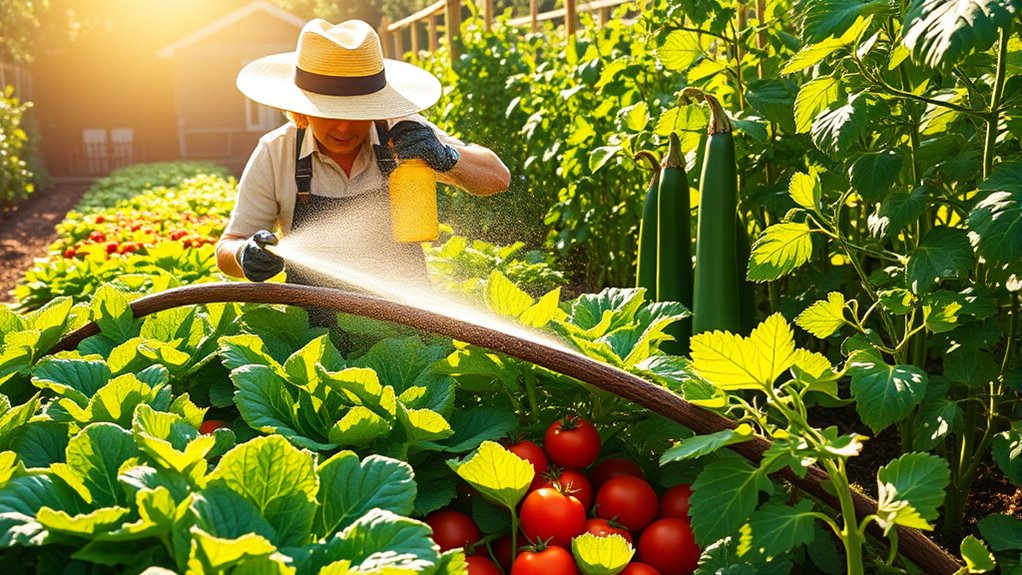
Bacillus thuringiensis (Bt) is a naturally occurring soil bacterium that acts as a targeted pest control agent in your garden. When applied, Bt produces proteins that specifically target certain insect larvae, disrupting their digestive systems and preventing them from causing damage. Unlike broad-spectrum pesticides, Bt doesn’t harm beneficial insects or your soil health, helping maintain a balanced ecosystem. This targeted action can enhance plant resistance over time, as healthier plants are better equipped to fend off pests naturally. By using Bt correctly, you support a sustainable gardening approach that protects your vegetables while preserving soil quality. Understanding how Bt works helps you apply it effectively, ensuring it contributes to a healthy, productive garden environment.
Selecting the Right Bt Formulation for Your Vegetables
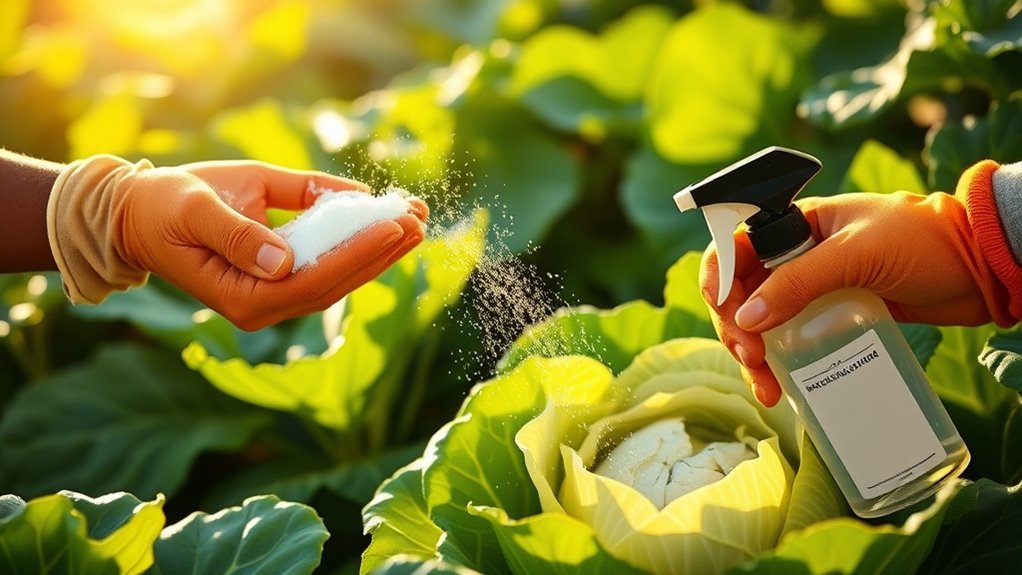
Choosing the right Bt formulation for your vegetables guarantees you get the most effective pest control without harming beneficial insects or your plants. Bt offers various formulation options, such as liquids, powders, or granules, allowing you to select based on your gardening needs. Pay attention to pest specificity; some formulations target specific pests like caterpillars or beetles, making them more efficient. Consider the stage of pest development and the type of vegetables you’re growing to choose a formulation best suited for your situation. Proper selection assures you maximize pest control while minimizing impact on non-target insects. Always read labels carefully to confirm the formulation’s pest targets and application methods, ensuring safe and effective use in your garden. Additionally, understanding the pest development stages can help you time applications more effectively for better results.
Proper Application Techniques for Maximum Effectiveness
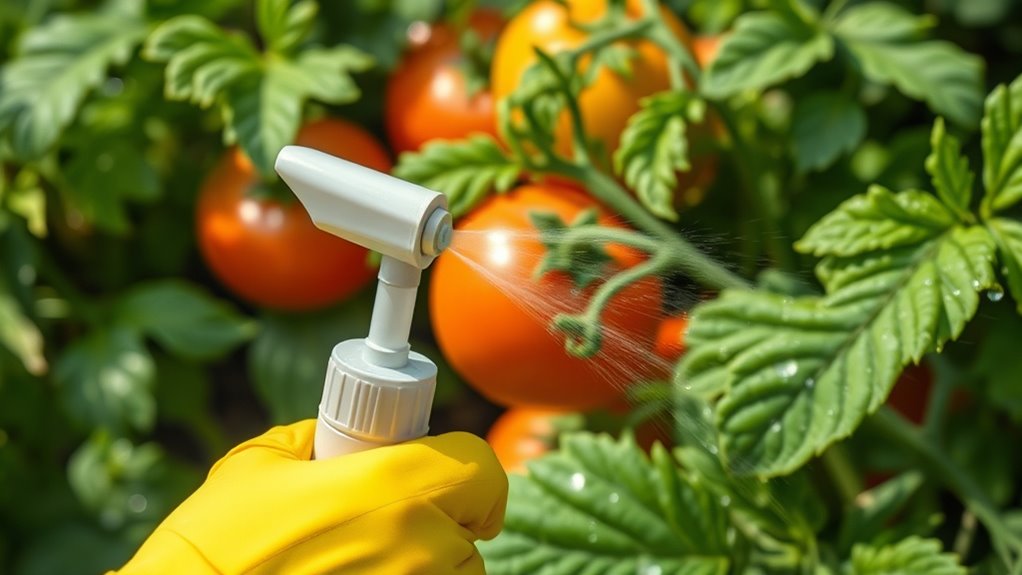
To guarantee your Bt application is effective, proper technique is essential. Begin by thoroughly mixing the solution and spraying evenly on all leaf surfaces, especially undersides where pests hide. Use a fine mist to ensure even coverage without runoff, which can harm soil health and beneficial insects. Apply in calm weather to prevent drift and avoid applying before rain, which can wash away the product. Regularly clean your sprayer to prevent contamination. Incorporate crop rotation into your pest management plan, reducing pest populations and minimizing the need for frequent applications. Proper application not only maximizes Bt’s effectiveness but also supports overall garden health by avoiding overuse that could disrupt soil balance and beneficial organisms. Additionally, selecting preppy dog names that reflect the personality traits of your dog can enhance your bond and make your pet stand out.
Timing Your Bt Treatments for Optimal Pest Control
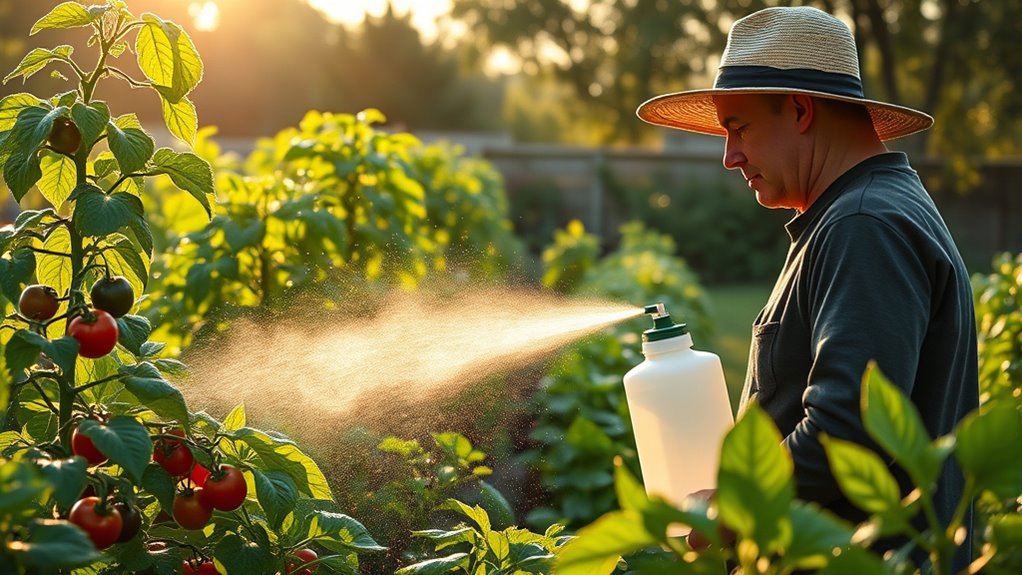
Applying Bt at the right time maximizes its ability to control pests effectively. Pay attention to seasonal pest patterns in your area, as pests tend to appear and peak at specific times. Monitor your garden regularly to catch infestations early, applying Bt when pest larvae are most vulnerable—usually shortly after eggs hatch. Timing treatments before pests cause significant damage ensures better control and reduces the need for repeated applications. Also, consider soil health; healthy soil promotes strong plants that are more resistant to pests, making timely Bt applications more effective. Be aware of pest lifecycle stages to optimize your treatment timing and improve pest management. Avoid unnecessary treatments during periods of low pest activity or when beneficial insects are abundant. Proper timing not only enhances pest control but also supports your garden’s overall health and sustainability.
Safety Precautions When Handling and Applying Bt

When handling Bt, always wear protective gear like gloves and a mask to prevent contact with spores. Make certain to apply it during the right times to avoid drift and guarantee effectiveness. Following these precautions helps keep you safe while effectively managing pests. Additionally, understanding the importance of proper timing can enhance the success of your application and minimize risks.
Protective Equipment Use
Handling and applying Bacillus thuringiensis (Bt) safely requires wearing the right protective gear to prevent skin contact and inhalation of spores. Always use gloves, long-sleeved shirts, and long pants to protect your skin from handling hazards. A mask or respirator helps prevent spores from entering your lungs, especially if you’re applying Bt in windy conditions. Eye protection, like goggles, guards against accidental splashes or drift. Before mixing or spraying, double-check your protective gear for tears or damage. Proper equipment minimizes your exposure to spores and reduces health risks. Remember, handling hazards can be mitigated with the right gear, ensuring you stay safe while effectively protecting your garden. Proper toilet maintenance and safety precautions are essential when handling any garden chemicals. Always prioritize safety to avoid unnecessary contact with Bt.
Proper Application Timing
To guarantee safe and effective use of Bacillus thuringiensis (Bt), timing your application correctly is essential. You should apply Bt when pests are actively feeding, which often matches their early larval stages. Proper pest identification helps determine the right time, as applying too early or late reduces effectiveness and may harm beneficial insects. Avoid applying Bt during windy conditions or when rain is expected, to prevent runoff into garden soil. Additionally, understanding target pest behavior can improve application success and minimize non-target impacts.
Avoiding Non-Target Harm: Protecting Beneficial Insects and Pollinators
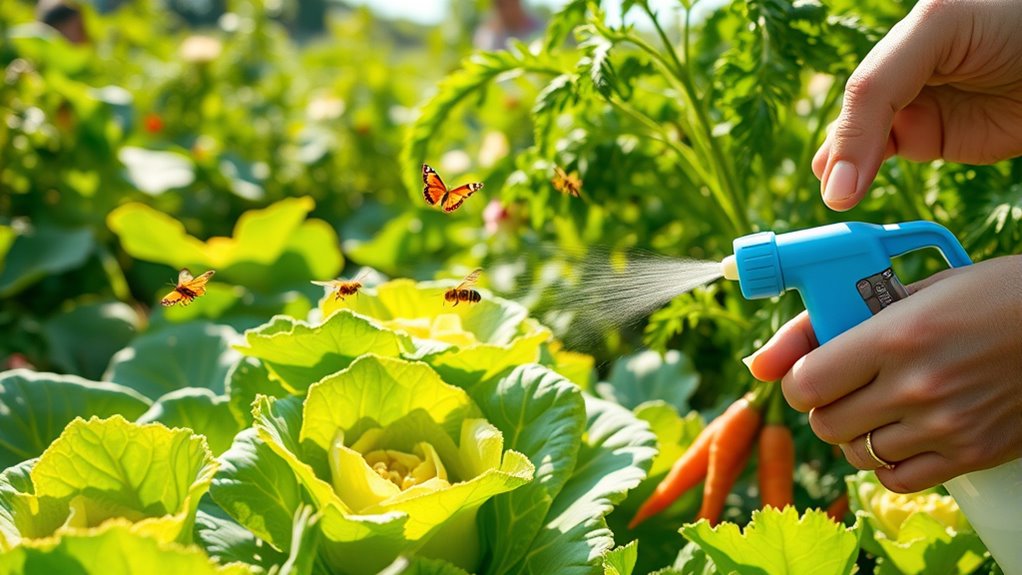
To safeguard beneficial insects and pollinators, you should time your Bt applications when these insects are less active, like early mornings or late evenings. Use targeted spraying methods to avoid overspreading, and steer clear of blooming plants that attract pollinators during treatment. This approach helps ensure your garden stays healthy for all its helpful visitors. Encouraging a mindful attention to your environment can further enhance the effectiveness of your pest management practices.
Timing Applications Carefully
Timing your Bacillus thuringiensis (Bt) applications carefully is essential to minimize harm to beneficial insects and pollinators. Applying Bt when pests are most active reduces the need for repeated treatments, supporting soil health and maintaining plant nutrition. To avoid unintended impacts, target applications during the early morning or late evening when pollinators are less active. Consider the table below to help plan your spray schedule:
| Time of Day | Pollinator Activity | Recommendations |
|---|---|---|
| Early Morning | Low | Ideal for application |
| Midday | Peak | Avoid spraying during this time |
| Late Afternoon | Increasing activity | Use caution if necessary |
| Evening | Declining | Suitable for application |
| Night | Minimal | Best time for precise targeting |
Additionally, understanding ecological balance helps in making informed decisions about pest control timing and methods.
Use Targeted Spraying Methods
Implementing targeted spraying methods guarantees that Bacillus thuringiensis (Bt) reaches only the pests you want to control, reducing unintended harm to beneficial insects and pollinators. Focus on precise application to minimize drift and overspray. Use a fine-tipped spray wand or applicator to target specific pests directly on affected plants. Avoid broadcasting Bt over large areas or during times when pollinators are active, such as early morning or late afternoon. Check weather conditions; wait for calm days to prevent spray from dispersing beyond your intended target. Be aware that caffeine levels in cocoa vary based on processing methods, so the concentration of Bt can also be managed by adjusting application rates accordingly. By practicing targeted spraying, you protect helpful insects while effectively managing pest populations, ensuring your garden’s ecological balance remains undisturbed. This careful approach helps maximize Bt’s benefits and minimizes risks to your garden’s essential pollinators.
Avoid Blooming Plants
Avoiding blooming plants when applying Bacillus thuringiensis (Bt) is crucial to protect beneficial insects and pollinators. Flowering plants attract bees and other pollinators that are essential for your garden’s health. If you spray Bt when plants are in bloom, you risk harming bee activity and disrupting pollination. To minimize this, apply Bt early in the morning or late in the evening when flowering plants are less attractive or not in bloom. Keep a safe distance from plants that are actively flowering, and avoid spraying during peak bee activity hours. This approach helps ensure that beneficial insects can continue their work without exposure to the bacteria, supporting a healthy, pollinated garden while effectively managing pests.
Storage and Shelf Life of Bt Products
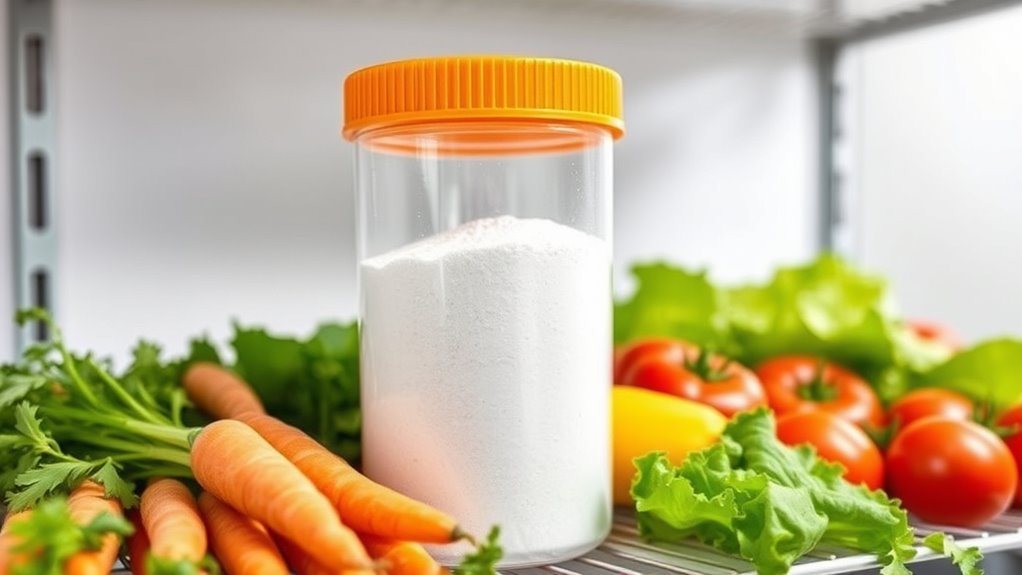
Proper storage is essential to maintain the effectiveness of Bacillus thuringiensis (Bt) products. Follow the storage guidelines provided on the label to ensure your Bt remains potent. Keep the product in a cool, dry place away from direct sunlight, heat, and moisture, as these conditions can degrade its effectiveness. Make certain the container is tightly sealed after each use to prevent contamination and moisture intrusion. Proper storage helps extend the shelf life of your Bt, often up to two years if stored correctly. Regularly check expiration dates and discard any expired products. Additionally, storing Bt in a controlled environment can help preserve its potency over time. By maintaining suitable storage conditions, you maximize the shelf life extension of your Bt, ensuring it remains effective when you need it for pest control in your garden.
Integrating Bt With Other Pest Management Strategies
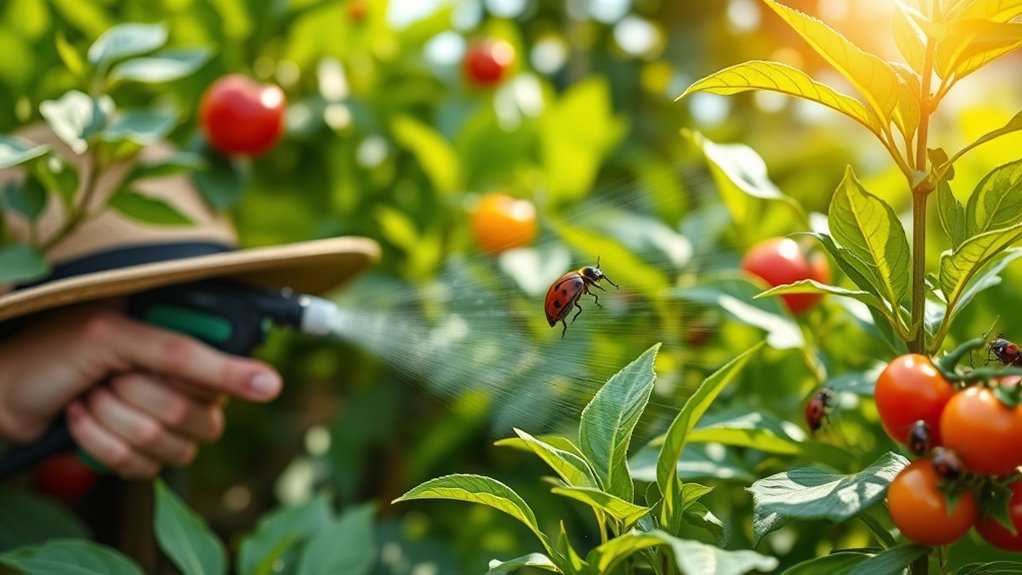
To effectively manage pests in your vegetable garden, it’s beneficial to combine Bacillus thuringiensis (Bt) with other pest control methods. Crop rotation helps break pest cycles and reduces the likelihood of infestations, making Bt more effective when pests are less prevalent. Companion planting also plays an essential role by deterring pests naturally; for example, marigolds can repel nematodes and aphids. Use Bt as part of an integrated approach, applying it when pest populations are low and supplementing with crop rotation and companion planting to minimize chemical reliance. This strategy not only enhances pest control but also promotes a healthier garden ecosystem. Combining these methods creates a balanced, sustainable approach that keeps pests at bay while safeguarding beneficial insects.
Monitoring and Assessing the Effectiveness of Bt Treatments
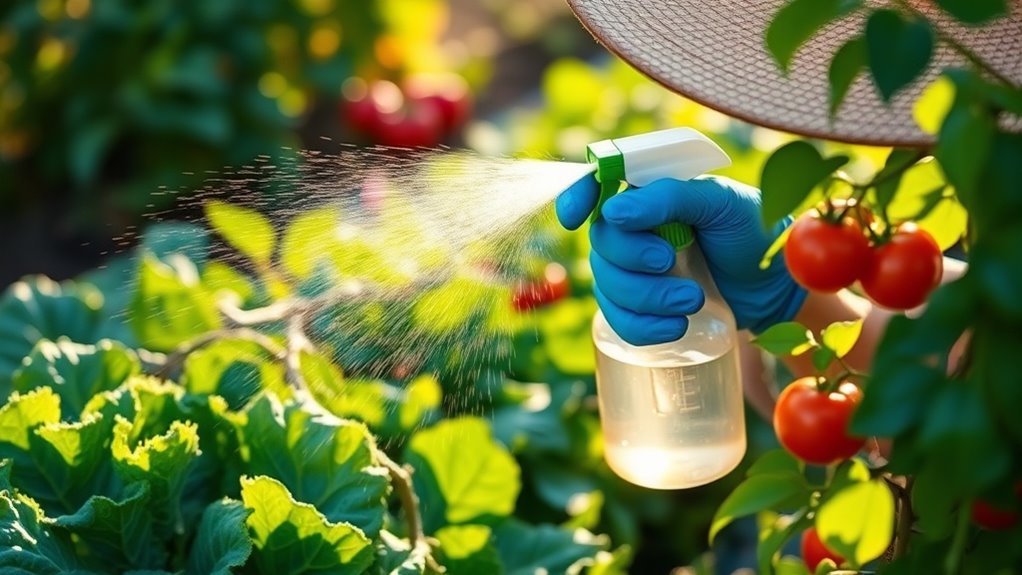
Monitoring and evaluating the effectiveness of Bt treatments is essential to guarantee your pest management efforts are working. Regularly observe your plants for pest activity and damage. Look for signs of pest resistance, which can reduce Bt’s effectiveness over time. Keep track of pest populations and damage levels to identify any decline or resurgence. Additionally, assess the environmental impact by noting any non-target insects or beneficial organisms affected.
To effectively monitor, consider these steps:
- Conduct frequent inspections, especially after application, to gauge pest presence.
- Record pest levels and plant health to identify trends.
- Adjust your approach if pests develop resistance or if unintended environmental effects become apparent, ensuring sustainable and safe use of Bt.
Frequently Asked Questions
Can Bt Be Used on Organic Vegetable Gardens?
You can definitely use Bt in your organic vegetable garden, as it’s approved for organic certification. Bt targets specific pests, helping prevent pest resistance when used correctly. It’s a safe, natural option that doesn’t harm beneficial insects or your plants. Just follow the label instructions carefully to maintain organic standards and guarantee effective pest control. This way, you protect your garden while staying within organic guidelines.
How Often Should I Reapply Bt During a Growing Season?
You should reapply Bt based on the pest lifecycle and application frequency guidelines. Typically, reapply every 7 to 10 days, especially after rain, to maintain effectiveness. Monitor pest activity closely, and reapply as needed when new infestations appear. Regular reapplication guarantees continuous protection, but avoid overuse. Adjust the frequency if pests are more active or if weather conditions affect Bt’s efficacy.
Are There Any Plants or Vegetables Incompatible With Bt?
You might worry about plant compatibility, but Bacillus Thuringiensis (Bt) generally works well with most vegetables. However, some plant restrictions exist, like avoiding Bt on plants with delicate or edible flowers, as it can affect pollinators or beneficial insects. While most vegetables are compatible, always read product labels for specific restrictions. This guarantees you use Bt safely without risking harm to your garden’s diverse plant life.
What Are Signs of Bt Overuse or Misuse in My Garden?
If you notice pests still damaging plants despite using Bt, it might be overused or misapplied. Signs include pest resistance, where pests become unaffected, and non-target effects, like harming beneficial insects or other wildlife. Overuse can lead to reduced effectiveness and ecological imbalance. To avoid this, follow application guidelines, rotate treatments, and monitor pest populations regularly, ensuring Bt remains a safe, effective option in your garden.
Can Bt Be Combined With Other Natural Pest Control Methods?
You can definitely combine Bt with other natural pest control methods. Using an integrated pest management approach helps you target pests effectively while minimizing harm to beneficial insects. Pair Bt with companion planting to deter pests naturally, and consider encouraging beneficial insects like ladybugs. This strategy creates a balanced garden environment, reducing the need for chemical interventions and promoting healthy plant growth. Always follow application guidelines to keep your garden safe and productive.
Conclusion
By using Bacillus thuringiensis wisely, you become the gardener guarding a delicate balance—each treatment a gentle whisper in the symphony of your garden’s health. When applied thoughtfully, Bt acts as a silent guardian, nurturing your vegetables while respecting nature’s intricate web. Remember, your careful stewardship symbolizes a pledge to protect not just your harvest, but the harmony of life itself, ensuring your garden thrives as a demonstration of mindful coexistence.

